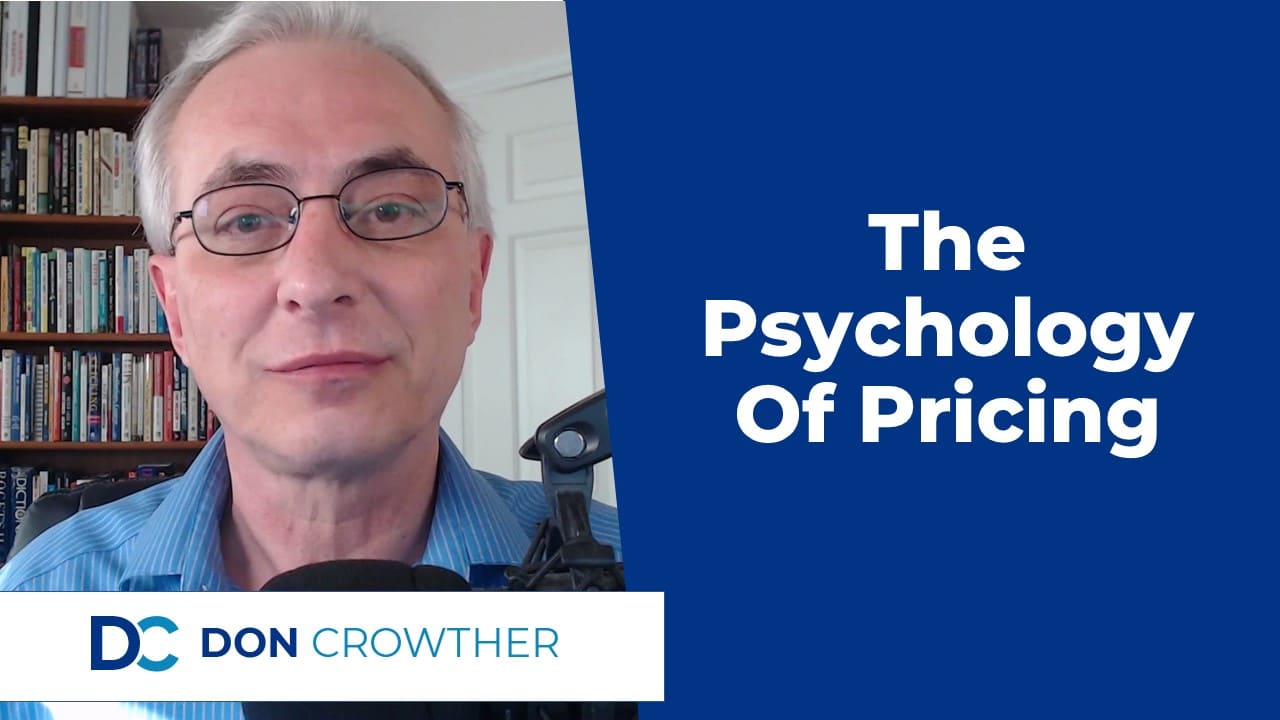Everyone who has to set a price for their goods and services in an environment where there isn’t a bunch of direct competitors all lined up on a shelf has to deal with it…
How much should I charge?
And here’s the problem – the process of setting that price is a huge psychological battle – with yourself.
Let’s talk about how to win that battle, so you can actually sell AND make money while you’re at it.
Let’s talk about pricing.
If you’re one of those people who doesn’t have to have your product sitting side by side with all of your competitors at the point of purchase, like toothpaste in a drugstore, you have a different set of questions to ask yourself when it comes to pricing.
This is especially true if you sell products like online course, coaching or consulting.
We all face this huge issue of what do we charge? I have a theory.
Pricing Theory:
Most of the time the price we choose for the products we sell has almost nothing to do with what our competitors are charging, the value that we create for people, or with what they’re able and willing to pay.
It has almost everything to do with how you feel about yourself.
In other words, the price you choose usually has almost nothing to do with rational decisions. Instead, it’s almost entirely emotionally based on your personal self-confidence.
Because here’s what ends up happening when you go through this process. Let’s say that you’re selling a product that you know of competitors selling a similar product for $1,000.
But if your self-confidence has taken a few dents, you tend to say, “hey wait a minute. If I charged $500 wouldn’t I sell a lot more?” Which seems to make a lot of sense.
But then as soon as you say, “maybe I should charge $500” then you start questioning that number and thinking, “if I charged $200 that’ll definitely sell more!”
And pretty soon you’re thinking about charging $100, or $50 or $10
Eventually it all comes down to your personal self-confidence: how you feel about yourself and the actual worth of the work you’re doing.
And, how do you feel about the value that you are giving to the people who buy your product?
Now I totally also agree that there are certain markets where it’s harder to charge more. For example, in the personal development marketplace, it’s a lot tougher to sell a $2,000 product.
But in most information-based markets, you have a wide range of prices that you can charge.
Pricing Factor #1: Price Elasticity
There’s a concept in economics called price elasticity, which basically says, if you increase the price, how much do sales go down? And if you decrease the price, how much do sales go up?
The problem of price elasticity is that it’s generally a myth when it comes to information kind of products.
Here’s what the average normal person thinks. “Okay, if I can sell a hundred units for $1,000 a piece, wow, if I charged $500 I’ll certainly sell a lot more than that.”
But the thing they fail to realize is that when cut the price in half to $500 they now have to sell double the number of units, 200 copies of that course to make the same amount of money they would have made if they sold it for $1,000 apiece.
It’s simple math, but most of the time the math doesn’t work that way. It’s extremely rare in the information marketplace where halving your price doubles the number of copies you’ll sell.
In fact, testing shows that decreasing your price by 50% will usually only increase sales by about 10% to 20%.
Let’s do the math. If you would have sold a hundred copies of your course for a thousand dollars each that’s $100,000.
But if you sold it for $500 let’s look at the high end of the 10-20% increase in sales and assume you’d sell 120 copies.
$500 * 120 = $60,000. So, we just lost $40,000.
And that $40,000 loss happens even though, in our heart of hearts, we truly believed we’d sell more if we charge less.
You’re right, you will – but only about 10 to 20% more, certainly not the 100% more than it takes to make up for that cost difference.
And you’ll lose $40,000 in the process…
It’s up to you. Buy into self-doubt and lose $40K or refuse to believe it and pocket the difference.
So that’s the first thing. Price elasticity is a myth when it comes to high dollar information products.
Pricing Factor #2: The Timeline of Pricing.
Imagine that you are two months out from introducing your product. You say “okay, I’m going to charge $1,000 for this product.”
But as you start getting closer to launch date, especially when you start doing your initial forays into marketing and you see that millions of people aren’t pouring in to get this information from you, what ends up happening is you say to yourself, “maybe this isn’t going to succeed all that well so I’d better cut my price.”
Pretty soon that thousand dollars becomes $500, then becomes $100, which eventually becomes $50.
This happens because you are making pricing decisions in the midst of peak anxiety about how well your product is going to do.
When you get tempted to do this, you need to remember that when you set that price at $1,000 two months ago, you had some rationale around that, based on the value you’re giving to people, what people are able and willing to pay, and competitive offerings. But, when it comes down to peak anxiety, most people are tempted to try to solve their anxiety by decreasing the price.
I encourage you to ask yourself the question, “what changed between two months ago and today, that would cause me rationally and logically to be willing to decrease that price.”
In most cases the answer to that question is “nothing really changed.”
Maybe people aren’t flocking to your launch videos the way you thought they would, but that does not mean that you need to decrease your price.
Usually what it means is you need to increase the power and the appeal of your offer. Put more into it with additional bonuses and core offerings to make your original price feel more worthwhile.
And remember as you do this that, as I said earlier, changing the price probably is not going to be a major determinant in sales.
One of my friends, Paul Meyers is so correct when he says, “there is no such thing as a pricing problem. There are only marketing problems.”
The solution when you become nervous that you’re not selling enough, is not to “fix” your price.
Instead, fix your marketing.
Because that’s what will make all the difference in the world.
Marketing includes the offer. It includes the lead generation. It includes how you’re talking to people. It includes your advertising, and your communications on your sales page, to name just a few. All those elements are the parts of the marketing that enable you to be able to make that price worth it.
Pricing Factor #3: Price Anchoring
Price anchoring is creating an explicit comparison between the price you’re asking and what people would have to pay to get the transformation you provide from other sources.
$1000 to get that transformation is a lot of money, until you realize that all the other ways to get it will cost them lots more.
They may have to hire a consultant for $50,000. They may have to work with you directly for $20,000. They might have to try to figure it out themselves and it’s going to cost them a year and $20,000 of their time.
When you properly anchor your price in a believable way, that $1000 looks cheap.
Consider these aspects when you work to decide what to charge for your products.
Ultimately it comes down to the question what do you think you’re worth? How confident are you in your ability to deliver the transformation that you’re promising people?
Choose a price that you truly believe meets those criteria. Then, by all means, stick to that price and give them 10 times what they paid for at that price.
This is Don Crowther, just go do this stuff.



Who is awesome? Don is!!!!!
Thank you! I really appreciate that!
This. Is. So. Important. Just what I needed to hear today – I’m the middle of my Open Cart Week Thank you for providing endless value, Don!
I believe you.
#TAKEAWAY Never do Math LIVE
I’m really not bad at math, it’s just when I’m in front of an audience, that part of my brain turns off. I think the talking part of my brain is demanding so much of the blood supply that the calculating part just can’t function.
Maybe that was my problem in High School when I tried to talk with girls. The “try not to make a fool of yourself” part of my brain was hogging all the blood supply, so the “say something that actually is interesting” part couldn’t function.
Don Crowther I’m sure neuroscientists would confirm your theory. Just wondering: Did you always try to “talk math” when you talked with girls in High School?!
I so need to hear this.
Oh Don… As I was considering lowering my price from $497 to 2 payments of $97 (and removing things from it) here is your video… This morning I decided to add value instead. Now you’ve reassured me. Thank you.
Yay- I’ve done my work here… Good for you!